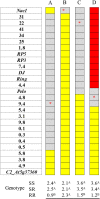A Novel Route Controlling Begomovirus Resistance by the Messenger RNA Surveillance Factor Pelota
- PMID: 26448569
- PMCID: PMC4598160
- DOI: 10.1371/journal.pgen.1005538
A Novel Route Controlling Begomovirus Resistance by the Messenger RNA Surveillance Factor Pelota
Abstract
Tomato yellow leaf curl virus (TYLCV) is a devastating disease of tomato (Solanum lycopersicum) that can be effectively controlled by the deployment of resistant cultivars. The TYLCV-resistant line TY172 carries a major recessive locus for TYLCV resistance, designated ty-5, on chromosome 4. In this study, the association between 27 polymorphic DNA markers, spanning the ty-5 locus, and the resistance characteristics of individual plants inoculated with TYLCV in 51 segregating recombinant populations were analyzed. These analyses localized ty-5 into a 425 bp region containing two transversions: one in the first exon of a gene encoding the tomato homolog of the messenger RNA surveillance factor Pelota (Pelo), and a second in its proximal promoter. Analyses of susceptible and resistant lines revealed that the relative transcript level of the gene remained unchanged, regardless of whether the plants were infected with TYLCV or not. This suggests that the polymorphism discovered in the coding region of the gene controls the resistance. Silencing of Pelo in a susceptible line rendered the transgenic plants highly resistant, while in the resistant line TY172 had no effect on symptom development. In addition, over-expression of the susceptible allele of the gene in the resistant TY172 line rendered it susceptible, while over-expression of the resistant allele in susceptible plants had no effect. These results confirm that Pelo is the gene controlling resistance at the ty-5 locus. Pelo, implicated in the ribosome recycling-phase of protein synthesis, offers an alternative route to promote resistance to TYLCV and other viruses.
Conflict of interest statement
The authors have declared that no competing interests exist.
Figures


References
-
- Cohen S, Harpaz I. Periodic rather than continual acquisition of a new tomato virus by its vector, the tobacco whitefly (Bemisia tabaci Gennadius). Entomol Exp Appl. 1964; 7: 155–166.
-
- Lapidot M, Friedmann M. Breeding for resistance to whitefly-transmitted geminiviruses. Ann Appl Biol. 2002; 140: 109–127.
Publication types
MeSH terms
Substances
Associated data
- Actions
- Actions
- Actions
- Actions
- Actions
- Actions
- Actions
- Actions
LinkOut - more resources
Full Text Sources
Other Literature Sources

